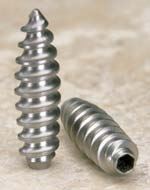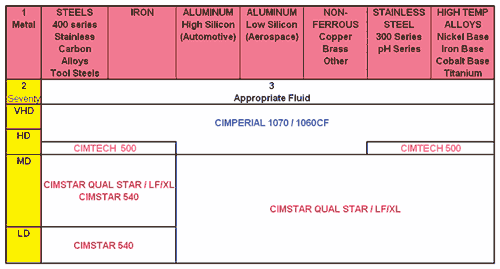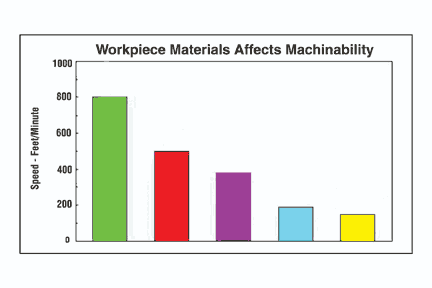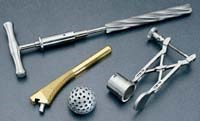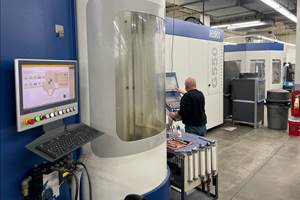Coolant Considerations For Medical Machining
While the proprietary nature of the actual metalworking processes used for making 'body parts' tends to be more mystique than technique, there are some things to think about for shops that are looking to do this kind of work.
Share




It’s no secret that one of the very few bright spots in the metalworking business has been the machining of medical components. It only makes sense if one considers the demographic glut of the aging baby boomer generation.
More bodies are reaching a point where replacement parts are needed. Demand creates supply with so many of us among that aging human fleet.
Like much of the high tech label that surrounds medicine and its practice, some shops are hesitant to consider medical machining applications because they believe the special demands may be beyond their capability. There are exceptions, but in general the metalworking process knowledge to make medical components is generic. Cutting metal is cutting metal, and although some of the materials specified for medical components might be considered “exotic” they are certainly not exclusive to medical applications.
One area of medical machining where a shop looking to create a successful process might need to understand a few things is the application of metalworking fluids. In general, traditional machining guidelines for fluid use are in effect for most medical machining applications, but there are some considerations in applying them that can help make the job easier.
We spoke to Tom McClure, manager of the fluids business at TechSolve (Cincinnati, Ohio), and Greg Foltz, engineering and development manager for Cimcool at Milacron Inc. (Cincinnati, Ohio), to learn more about the role of metalworking fluids in machining of medical components.
Medical Parts
There are two main categories of machined parts for medical applications. They are components that are implanted in the body on a permanent or semi-permanent basis and those that are used in the body for short durations, such as during surgery. Most of the specialized cutting fluid considerations are targeted at the transplanted parts.
Implanted components such as hip joints, knee joints, bone screws, spinal fusion plates and other hardware must be designed to withstand a relatively tough environment within the human body. Many of these components are specified to be made from tough materials such as titanium and nickel alloys to withstand a hopefully long service life within the acidic environment that exists in our bodies, which have a general pH of around 5.4.
Greatly simplified, on skeletal replacement or reinforcement parts, the hope is that once the component is in place, the surrounding tissue will adhere to the surface of the metal—literally grow on it to form a strong connection—like a weld. This critical union between body and part is where what the shop did upstream through its application of metalworking fluid and the subsequent cleaning of the parts can be a determining factor in the transplant’s success.
Oil Is OK, But Be Careful
According to Mr. McClure, most of the medical machining shops that TechSolve has worked with use water-based coolants in their medical parts manufacturing. “That’s not to say oils cannot be used,” he says, “but the cleaning of those components must be especially thorough.”
It seems there was a lawsuit filed against a medical parts supplier after a batch of implanted parts failed to knit with the surrounding tissue. These had to be removed and replaced. No doubt the malpractice lawyers had a field day.
Analysis showed that microscopic amounts of the cutting oil were present in the microstructure of the implanted part. This residue was sufficient to prevent the tissue from bonding to the component. This is a patient’s horror story for sure, and a cautionary tale to parts suppliers.
Obviously if cutting oil is the right fluid for the job, the shop should use it. But it is important to make sure the subsequent cleaning process can get the oil off the parts.
Coolant Considerations
For medical component applications, coolant selection is a twofold exercise. First, of course, are the performance characteristics created by the interaction among the coolant, cutting tool material and the workpiece material. These are generic concerns applicable to any metalworking process.
Looking then at synthetic and semi-synthetic coolants, what should the shop think about? Matching the right coolant to the job is, of course, key. It is also important to reduce any incidences for bacterial growth in the coolant. According to Mr. McClure, most shops doing medical machining make coolant cleanliness a higher priority than is generally seen in traditional shops.
Coolant tanks are covered, and nothing foreign is allowed into the system. Way oil is monitored and removed regularly. Many shops use individual coolant tanks, one for each machine. In the case of an outbreak of bacteria or other contamination, dumping a single tank is less disruptive to production than dumping a central system, and it isolates any problems to a single machine instead of the entire shop.
Flood coolant application is generally the application system of choice for implanted medical parts cutting. High pressure coolant systems are not widely used for fear they can deposit coolant in pores of the metal, complicating cleaning.
Clean parts are the bottom line consideration for machining implanted medical components. Coolant selection plays a role in this.
Complicating the making of implanted parts is the capability to remove any residue from the parts that is used in their manufacture. In other words, if you can’t clean it, don’t use it.
As an example, many shops rely on ultrasonic parts cleaning for complex, cavity riddled workpieces. Such cleaning systems work well at getting into nooks and crannies on a workpiece. However, some workpiece materials are sensitive to ultrasonic, which can induce micro-fractures in the workpiece.
Think Aerospace
For shops looking at machining medical parts, both Mr. McClure and Mr. Foltz agree that the best model to follow is machining of aerospace components, especially engine parts. If you think about it, it’s true. Aerospace manufacture is regulated by the FAA, which imposes traceability and process qualification standards for making the parts that go into commercial and military aviation.
The medical parts business is under the auspices of the FDA, which likewise demands that parts be traceable to the source and qualifies production processes as meeting the regulatory standards. In both industries, once a process is qualified, there is some inertia to make changes because of the regulatory red tape involved. Getting the process correct and sustainable should be a goal for machining medical components.
Related Content
Tungaloy-NTK PCD Grade Optimizes Dimensional Accuracy
The DX200 is an effective tool for machining application-specific components that demand high levels of material purity, such as metal medical implants and sputtering targets for semiconductor applications.
Read MoreGerman Project Yields Three New Medical Machining Processes
Trends to Watch at IMTS: Recent research has resulted in a new mix of high-speed turn whirl milling, polygon turning and rotational turning for manufacturing medical bone screws and out-of-round nails.
Read MoreFive-Axis Turnkey Machine Halves Medical Shop’s Cycle Times
Horizontal five-axis machines cut cycle times in half at ARCH Medical Solutions – Newtown. But its leadership gives equal credit to a surprising factor: the OEM’s service department.
Read MoreOrthopedic Event Discusses Manufacturing Strategies
At the seminar, representatives from multiple companies discussed strategies for making orthopedic devices accurately and efficiently.
Read MoreRead Next
Building Out a Foundation for Student Machinists
Autodesk and Haas have teamed up to produce an introductory course for students that covers the basics of CAD, CAM and CNC while providing them with a portfolio part.
Read More5 Rules of Thumb for Buying CNC Machine Tools
Use these tips to carefully plan your machine tool purchases and to avoid regretting your decision later.
Read MoreRegistration Now Open for the Precision Machining Technology Show (PMTS) 2025
The precision machining industry’s premier event returns to Cleveland, OH, April 1-3.
Read More













